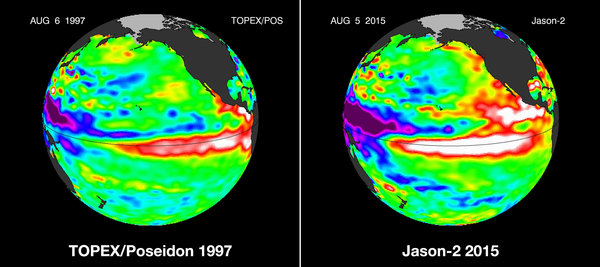FYI
Some say the current weather we are experiencing in the western US is not indicative of a trend fostered by anthropogenic forcing of the radiative balance, but rather El Nino–warmer sea surface temperatures in the Pacific Ocean.
Large-scale weather events like warmer sea surface temperatures (like El Nino), affect dependent weather (sub) systems like drought, or rain storms, or beautiful August nights. Systems like ENSO (El Nino), the AO, the PDO, or the NAO have sway over smaller weather events.
The hierarchy looks like this: Climate changes affect large weather systems. The large systems impact smaller weather systems. The resulting weather events impact our economy. (Oh damn. Sorry, I am so embarrassed. I meant to say the resulting weather events impact human life.)
Think lots of water on the planet, less land.
Look at the pictures below.
The picture on the left is the El Nino of 1997. On the right is El Nino of 2015. Do you see the difference? The big red and white blob indicating increased sea surface temperatures is located further into the central Pacific–rather than sitting in the eastern Pacific close to North America. It is also larger. An eastern Pacific El Nino had been the pattern in the past. A central Pacific El Nino is the pattern of the present. Anthropogenic forcing of the radiative balance has moved the location of the El Nino and that modification of location has altered El Nino’s day to day impacts.
Large-scale weather patterns will vary considerably in the near future. Therefore, so will small-scale weather patterns.
Confusing the layperson by interchanging weather and climate in discussion without demarcation does little for addressing the climate crisis. Rather, obfuscation weakens the political will of the population making appropriate responses to, and mitigation of, the climate crisis more difficult to implement. On the other hand, when civilization collapses the Dow might be at an all time high. (An occasion that makes Eliot’s “Whimper” seem almost noble–though even more morose.)
The El Nino locating in the central Pacific is powerful and it has sway over smaller weather patterns. So the argument that El Nino controls our weather and not the changing climate is kinda’ right; however, intentionally confusing climate and weather leads us to a cliff, and then off, into the academic abyss of analysis paralysis.
Weather is not a negation of climate dominance. Weather is climate perceived.

Sorry, the comment form is closed at this time.